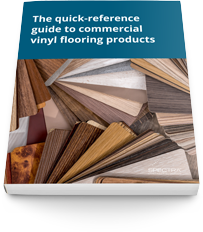VCT installation: What you need to know
Also referred to as resilient flooring, commercial vinyl flooring is increasing in popularity due to its versatility, look and the low price tag. If you’re shopping around for vinyl flooring for your facility, there are several options: luxury vinyl tile (LVT), sheet flooring and vinyl composition tile (VCT). While all have their strengths, for those looking for durability and low maintenance costs, VCT is worthy of your consideration.
VCT is comprised of natural limestone, filler materials, a thermoplastic binder and color pigments. The individual tiles come in all shapes and sizes, but your typical VCT tile is about 12” x 12” and 1/8” thick. Weighing about a pound, the tile is durable and strong, but resilient due to the flexibility that the vinyl binders offer.
Digital graphic layers allow manufacturers to make VCT that mimics the look of more expensive materials such as wood, terrazzo and stone. This means that VCT can be used with almost any design scheme. That, paired with the low cost of VCT installation and the ease of maintenance, makes VCT an attractive option for a variety of commercial applications.
Here’s how to painlessly conduct your next VCT installation project:
- Snap your grid lines
Undoubtedly, you’ll have the design of the room in mind when choosing flooring. Whether you’re looking for a simple checkerboard pattern or implementing a complex design scheme, making sure you follow a grid is crucial. First, you’ll want to find the center of the room, and work outward, snapping grid lines and allowing for small spaces between each tile. Then, dry lay the tiles to ensure your design scheme will fit. This process will ensure that the rest of the VCT installation goes smoothly.
- Spread the VCT adhesive
On the underside of most VCT tiles, you’ll usually find dry back application. That means that you will have to use glue during VCT installation in order to make the tiles stay in place. It usually takes about an hour to spread VCT adhesive evenly across the floor. VCT adhesive typically has about six hours of working time, which means you might have to spread the glue and lay the tile in sections, especially in big rooms.
- Lay the tile
Once you’ve spread the glue, the next step in VCT installation is to actually lay the tile. When laying tile, it’s good to remember that the first tile sets the tone for the rest of the installation. If the first tile is off, every tile you lay afterward will follow suit. Perfectionism is key with each tile you lay. Once the tile is laid, you should use a floor roller to make sure your tile is uniform and flat when it sets.
- Finish it off
VCT often comes with a factory coat of polish. While this protects the tile during shipment, it is recommended that you remove it and refinish it with several coats of your own polish. This can easily be done with buffing equipment and chemical strippers. Once you put those last couple coats of polish on your tile, your VCT installation is complete …
- Maintenance and upkeep
… Well, almost. Once the initial installation is complete, you have to keep up the look and feel of the tile. VCT is resistant to sunlight, abrasions and high foot traffic, but in the case that there is a crack or the polish fades, it’s easily repaired. If the flooring is laid correctly, individual tiles can easily be removed and replaced. Polish reapplications are done easily using the process described above.
To make sure your next VCT installation project goes seamlessly, you need to choose a commercial flooring contractor that understands the flooring process inside and out. At Spectra Contract Flooring, we’ve completed over 350,000 flooring installations and would love to hear about your particular needs.
To learn more about VCT, check out our quick-reference guide to vinyl flooring products. You’ll receive quick takeaways about the pros, cons, price and performance of LVT, VCT and vinyl sheet flooring. Download your guide today.

Reference guide to commercial vinyl flooring products
Take the guesswork out of vinyl product selection. This guide cuts through the noise, offering you quick takeaways about the pros, cons, price and performance of LVT, VCT and vinyl sheet flooring.
